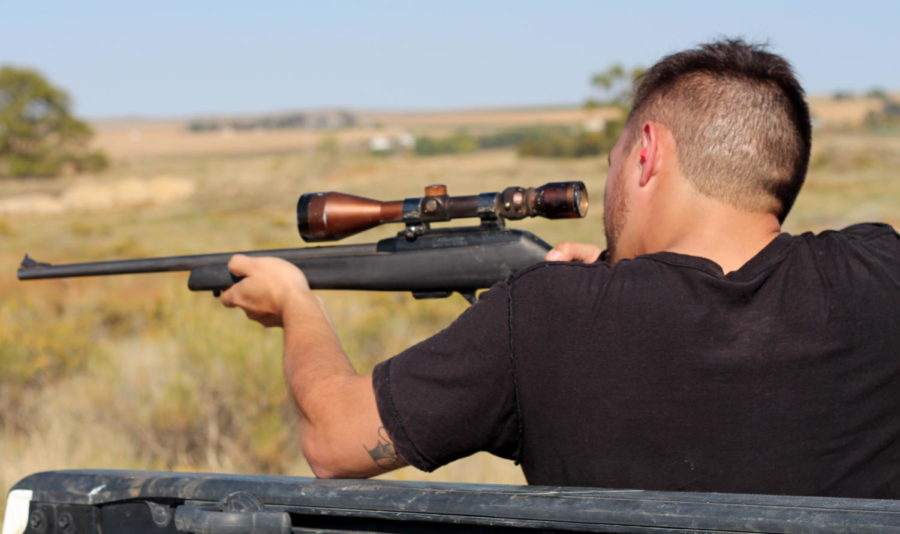Eisenstein: Even if you do not own a firearm…
November 3, 2021
On the 21st of October, Film Producer and Actor Alec Baldwin discharged a firearm, wounding director Joel Souza and killing cinematographer Haylna Hutchins. Although the investigation is still ongoing, the fallout from the tragedy is rife with finger-pointing and political exploitation. There is no disagreement, however, that this incident was tragic and avoidable.
Even if you never think you will need to handle a firearm, you should know the basic rules of firearm safety. I believe this for two reasons, the first being that luck tends to favor the prepared. In other words, you never know when an unexpected event may lead to you needing to handle a firearm, whether it be a bachelor party’s ad-hoc stop at a firing range or an event of apocalyptic significance, for example. The basic rules of firearm safety can also be applied to other activities, like handling knives, machinery, vehicles or other potentially dangerous objects.
The four basic rules of firearm safety are as follows:
Rule #1: Treat every firearm as if it is loaded.
Assume every firearm is loaded until you verify otherwise. In order to perform cleaning and other maintenance, you may need to check that a firearm is not loaded. Never take someone’s word for it that a firearm is not loaded. If you do not know how to check, do your research and learn how. If an unloaded firearm is out of your possession for any period of time, check it again after taking possession. There is never a penalty for checking, but there may be a severe penalty for failure to check.
Rule #2: Do not point a firearm at anything you do not intend to destroy.
Not only is it rude to point objects at people, but with firearms, it can have destructive or deadly consequences. A way to think of this is that there is a laser emitted from the barrel of every firearm. Do not let it come near anyone or anything you do not intend to destroy. Remember that once a shot is fired, it cannot be called back.
Rule #3: Keep your finger off the trigger until you are ready to fire.
From my experience, this rule is the hardest for newer shooters to remember. This rule is frequently broken in movies and television shows, like Netflix’s “Squid Game,” for example. Consequently, it is not always common knowledge. It may not be intuitive, but most firearms are designed so that if you keep your index finger straight, you can rest your index finger on the area just above the trigger.
Rule #4: Always be aware of what is ahead of and behind your intended target.
In other words, do not get tunnel vision! Be aware of anyone or anything that can wander into the line of fire, and consider what the bullet may hit if it travels beyond its intended target. As a side note, also be aware of any surrounding obstacles in order to avoid losing your balance and, consequently, losing control of your firearm.
Whenever I take someone to a shooting range, I always make sure that they have these rules memorized verbatim before letting them handle a firearm. But, those are not the only rules to consider.
What about the safety switch?
Not every firearm has a “safety switch.” Firearms that have safety switches are equipped with mechanical devices that internally inhibit the function of the trigger. Activating the safety switch is recommended whenever you do not intend to use a firearm. But, given they are mechanical devices, they are subject to possible failure, and, for that reason, they should never be used to substitute any of the aforementioned rules of firearm safety.
If you do not trust yourself to drive a car, do not handle a firearm. Iowa law prohibits carrying a weapon while intoxicated. (ILC § 724.4C) But, if you do not trust yourself to drive a vehicle, whether it be that you consumed an intoxicating substance, are feeling tired or sick, or are under any significant emotional distress, for example, please do not handle a firearm.
Research the firearm and learn what to look for. If you have an advance notice of what kind of firearm you will be handling, or if you plan on purchasing the firearm yourself, do your research! Learn how to operate it, learn what kind of mechanical issues to keep an eye out for, and learn what kind of ammunition it fires, for example.
Last but certainly not least, get to know the laws. (Note: I am not a lawyer, and I cannot offer legal advice.) From the National Firearms Act of 1934 to the Brady Handgun Violence Prevention Act of 1993 and all the federal firearm laws in between, you could be walking into a legal minefield if you do not know what you are doing. The same can be said for the unique laws of all states and U.S. territories. Make sure you know the firearm-related laws of the state you live in as well as any state you plan on transporting firearms to. The National Rifle Association Institute for Legislative Action offers a very helpful resource offering summaries of all state and U.S. territory laws pertaining to firearms.
Firearms are incredibly fun, versatile and effective tools for recreation, competition and self-defense. But the power they bring requires an equal amount of responsibility. This column is not comprehensive, and I did not list any specifics pertaining to hunting, public firing ranges, or self-defense situations. But, with a little patience and studying, you too can safely enjoy our rights protected under the Second Amendment of the United States Constitution.







